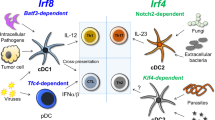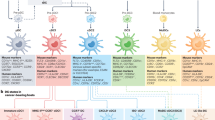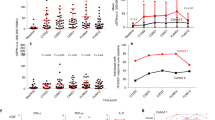Abstract
The development of an effective vaccine that elicits a strong and durable T cell response against intracellular pathogens and cancer is a challenge. One strategy to enhance the effectiveness of vaccination is by targeting dendritic cells (DCs). In this Opinion article, we discuss existing DC-targeting approaches that induce adaptive immunity. We highlight the crucial issues that need to be addressed to move the field forward and discuss whether targeting DCs could be better than current vaccine approaches.
This is a preview of subscription content, access via your institution
Access options
Subscribe to this journal
Receive 12 print issues and online access
$259.00 per year
only $21.58 per issue
Buy this article
- Purchase on SpringerLink
- Instant access to full article PDF
Prices may be subject to local taxes which are calculated during checkout

Similar content being viewed by others
References
Plotkin, S. A. Vaccines: correlates of vaccine-induced immunity. Clin. Infect. Dis. 47, 401–409 (2008).
Tomaras, G. D. & Haynes, B. F. Advancing toward HIV-1 vaccine efficacy through the intersections of immune correlates. Vaccines 2, 15–35 (2014).
de Souza, J. B. Protective immunity against malaria after vaccination. Parasite Immunol. 36, 131–139 (2014).
Andersen, P. & Woodworth, J. S. Tuberculosis vaccines — rethinking the current paradigm. Trends Immunol. 35, 387–395 (2014).
Guermonprez, P., Valladeau, J., Zitvogel, L., Thery, C. & Amigorena, S. Antigen presentation and T cell stimulation by dendritic cells. Annu. Rev. Immunol. 20, 621–667 (2002).
Schuler, G., Schuler-Thurner, B. & Steinman, R. M. The use of dendritic cells in cancer immunotherapy. Curr. Opin. Immunol. 15, 138–147 (2003).
Palucka, K. & Banchereau, J. Cancer immunotherapy via dendritic cells. Nature Rev. Cancer 12, 265–277 (2012).
Palucka, A. K. et al. Dendritic cells loaded with killed allogeneic melanoma cells can induce objective clinical responses and MART-1 specific CD8+ T-cell immunity. J. Immunother. 29, 545–557 (2006).
Frankenberger, B. & Schendel, D. J. Third generation dendritic cell vaccines for tumor immunotherapy. Eur. J. Cell Biol. 91, 53–58 (2012).
Wimmers, F., Schreibelt, G., Skold, A. E., Figdor, C. G. & De Vries, I. J. Paradigm shift in dendritic cell-based immunotherapy: from in vitro generated monocyte-derived DCs to naturally circulating DC subsets. Front. Immunol. 5, 165 (2014).
Blander, J. M. & Medzhitov, R. Toll-dependent selection of microbial antigens for presentation by dendritic cells. Nature 440, 808–812 (2006).
Sporri, R. & Reis e Sousa, C. Inflammatory mediators are insufficient for full dendritic cell activation and promote expansion of CD4+ T cell populations lacking helper function. Nature Immunol. 6, 163–170 (2005).
Wong, P. & Pamer, E. G. CD8 T cell responses to infectious pathogens. Annu. Rev. Immunol. 21, 29–70 (2003).
Reed, S. G., Bertholet, S., Coler, R. N. & Friede, M. New horizons in adjuvants for vaccine development. Trends Immunol. 30, 23–32 (2009).
Coffman, R. L., Sher, A. & Seder, R. A. Vaccine adjuvants: putting innate immunity to work. Immunity 33, 492–503 (2010).
Cho, H. J. et al. Immunostimulatory DNA-based vaccines induce cytotoxic lymphocyte activity by a T-helper cell-independent mechanism. Nature Biotechnol. 18, 509–514 (2000).
Tighe, H. et al. Conjugation of protein to immunostimulatory DNA results in a rapid, long-lasting and potent induction of cell-mediated and humoral immunity. Eur. J. Immunol. 30, 1939–1947 (2000).
Tighe, H. et al. Conjugation of immunostimulatory DNA to the short ragweed allergen Amb a 1 enhances its immunogenicity and reduces its allergenicity. J. Allergy Clin. Immunol. 106, 124–134 (2000).
Wille-Reece, U., Wu, C.-Y., Flynn, B. J., Kedl, R. M. & Seder, R. A. Immunization with HIV-1 Gag protein conjugated to a TLR7/8 agonist results in the generation of HIV-1 Gag-specific Th1 and CD8+ T cell responses. J. Immunol. 174, 7676–7683 (2005).
Kastenmüller, K. et al. Protective T cell immunity in mice following protein-TLR7/8 agonist-conjugate immunization requires aggregation, type I IFN, and multiple DC subsets. J. Clin. Invest. 121, 1782–1796 (2011).
Wille-Reece, U. et al. HIV Gag protein conjugated to a Toll-like receptor 7/8 agonist improves the magnitude and quality of Th1 and CD8+ T cell responses in nonhuman primates. Proc. Natl Acad. Sci. USA 102, 15190–15194 (2005).
Snider, D. P. & Segal, D. M. Targeted antigen presentation using crosslinked antibody heteroaggregates. J. Immunol. 139, 1609–1616 (1987).
Carayanniotis, G. & Barber, B. H. Adjuvant-free IgG responses induced with antigen coupled to antibodies against class II MHC. Nature 327, 59–61 (1987).
Frleta, D., Demian, D. & Wade, W. F. Class II-targeted antigen is superior to CD40-targeted antigen at stimulating humoral responses in vivo. Int. Immunopharmacol. 1, 265–275 (2001).
Tewari, K. et al. Poly(I:C) is an effective adjuvant for antibody and multi-functional CD4+ T cell responses to Plasmodium falciparum circumsporozoite protein (CSP) and αDEC-CSP in non human primates. Vaccine 28, 7256–7266 (2010).
Bachem, A. et al. Superior antigen cross-presentation and XCR1 expression define human CD11c+CD141+ cells as homologues of mouse CD8+ dendritic cells. J. Exp. Med. 207, 1273–1281 (2010).
Crozat, K. et al. The XC chemokine receptor 1 is a conserved selective marker of mammalian cells homologous to mouse CD8α+ dendritic cells. J. Exp. Med. 207, 1283–1292 (2010).
Jongbloed, S. L. et al. Human CD141+ (BDCA-3)+ dendritic cells (DCs) represent a unique myeloid DC subset that cross-presents necrotic cell antigens. J. Exp. Med. 207, 1247–1260 (2010).
Poulin, L. F. et al. Characterization of human DNGR-1+ BDCA3+ leukocytes as putative equivalents of mouse CD8α+ dendritic cells. J. Exp. Med. 207, 1261–1271 (2010).
Sancho, D. et al. Tumor therapy in mice via antigen targeting to a novel, DC-restricted C-type lectin. J. Clin. Invest. 118, 2098–2110 (2008).
Joffre, O. P., Sancho, D., Zelenay, S., Keller, A. M. & Reis e Sousa, C. Efficient and versatile manipulation of the peripheral CD4+ T-cell compartment by antigen targeting to DNGR-1/CLEC9A. Eur. J. Immunol. 40, 1255–1265 (2010).
Mascarell, L. et al. Delivery of the HIV-1 Tat protein to dendritic cells by the CyaA vector induces specific Th1 responses and high affinity neutralizing antibodies in non human primates. Vaccine 24, 3490–3499 (2006).
Mascarell, L., Fayolle, C., Bauche, C., Ladant, D. & Leclerc, C. Induction of neutralizing antibodies and Th1-polarized and CD4-independent CD8+ T-cell responses following delivery of human immunodeficiency virus type 1 Tat protein by recombinant adenylate cyclase of Bordetella pertussis. J. Virol. 79, 9872–9884 (2005).
Steinman, R. M. & Banchereau, J. Taking dendritic cells into medicine. Nature 449, 419–426 (2007).
Idoyaga, J. et al. Cutting edge: langerin/CD207 receptor on dendritic cells mediates efficient antigen presentation on MHC I and II products in vivo. J. Immunol. 180, 3647–3650 (2008).
Idoyaga, J. et al. Comparable T helper 1 (Th1) and CD8 T-cell immunity by targeting HIV gag p24 to CD8 dendritic cells within antibodies to Langerin, DEC205, and Clec9A. Proc. Natl Acad. Sci. USA 108, 2384–2389 (2011).
Idoyaga, J. et al. Specialized role of migratory dendritic cells in peripheral tolerance induction. J. Clin. Invest. 123, 844–854 (2013).
Lahoud, M. H. et al. Targeting antigen to mouse dendritic cells via Clec9A induces potent CD4 T cell responses biased toward a follicular helper phenotype. J. Immunol. 187, 842–850 (2011).
Castro, F. V. V. et al. CD11c provides an effective immunotarget for the generation of both CD4 and CD8 T cell responses. Eur. J. Immunol. 38, 2263–2273 (2008).
White, A. L. et al. Ligation of CD11c during vaccination promotes germinal centre induction and robust humoral responses without adjuvant. Immunology 131, 141–151 (2010).
Van Montfoort, N. et al. Circulating specific antibodies enhance systemic cross-priming by delivery of complexed antigen to dendritic cells in vivo. Eur. J. Immunol. 42, 598–606 (2012).
Chatterjee, B. et al. Internalization and endosomal degradation of receptor-bound antigens regulate the efficiency of cross presentation by human dendritic cells. Blood 120, 2011–2020 (2012).
Cohn, L. et al. Antigen delivery to early endosomes eliminates the superiority of human blood BDCA3+ dendritic cells at cross presentation. J. Exp. Med. 210, 1049–1063 (2013).
Li, D. et al. Targeting self- and foreign antigens to dendritic cells via DC-ASGPR generates IL-10-producing suppressive CD4+ T cells. J. Exp. Med. 209, 109–121 (2012).
Valladeau, J. et al. Immature human dendritic cells express asialoglycoprotein receptor isoforms for efficient receptor-mediated endocytosis. J. Immunol. 167, 5767–5774 (2001).
Kreutz, M., Tacken, P. J. & Figdor, C. G. Targeting dendritic cells—why bother? Blood 121, 2836–2844 (2013).
Flynn, B. J. et al. Immunization with HIV Gag targeted to dendritic cells followed by recombinant New York vaccinia virus induces robust T-cell immunity in nonhuman primates. Proc. Natl Acad. Sci. USA 108, 7131–7136 (2011).
Segura, E. & Amigorena, S. Cross-presentation by human dendritic cell subsets. Immunol. Lett. 158, 73–78 (2013).
Jaitin, D. A. et al. Massively parallel single-cell RNA-seq for marker-free decomposition of tissues into cell types. Science 343, 776–779 (2014).
Xue, J. et al. Transcriptome-based network analysis reveals a spectrum model of human macrophage activation. Immunity 40, 274–288 (2014).
Gross, O. et al. Card9 controls a non-TLR signalling pathway for innate anti-fungal immunity. Nature 442, 651–656 (2006).
Burgdorf, S., Kautz, A., Bohnert, V., Knolle, P. A. & Kurts, C. Distinct pathways of antigen uptake and intracellular routing in CD4 and CD8 T cell activation. Science 316, 612–616 (2007).
Sancho, D. et al. Identification of a dendritic cell receptor that couples sensing of necrosis to immunity. Nature 458, 899–903 (2009).
Brahmer, J. R. et al. Safety and activity of anti-PD-L1 antibody in patients with advanced cancer. N. Engl. J. Med. 366, 2455–2465 (2012).
Topalian, S. L. et al. Safety, activity, and immune correlates of anti-PD-1 antibody in cancer. N. Engl. J. Med. 366, 2443–2454 (2012).
Honda, T. et al. Tuning of antigen sensitivity by T cell receptor-dependent negative feedback controls T cell effector function in inflamed tissues. Immunity 40, 235–247 (2014).
Hamzah, J. et al. Vascular normalization in Rgs5-deficient tumours promotes immune destruction. Nature 453, 410–414 (2008).
Pardoll, D. M. The blockade of immune checkpoints in cancer immunotherapy. Nature Rev. Cancer 12, 252–264 (2012).
Heit, A. et al. Cutting edge: Toll-like receptor 9 expression is not required for CpG DNA-aided cross-presentation of DNA-conjugated antigens but essential for cross-priming of CD8 T cells. J. Immunol. 170, 2802–2805 (2003).
Horner, A. A. et al. Immunostimulatory DNA-based vaccines elicit multifaceted immune responses against HIV at systemic and mucosal sites. J. Immunol. 167, 1584–1591 (2001).
Heit, A. et al. Protective CD8 T cell immunity triggered by CpG-protein conjugates competes with the efficacy of live vaccines. J. Immunol. 174, 4373–4380 (2005).
Heit, A. et al. Circumvention of regulatory CD4+ T cell activity during cross-priming strongly enhances T cell-mediated immunity. Eur. J. Immunol. 38, 1585–1597 (2008).
Huleatt, J. W. et al. Vaccination with recombinant fusion proteins incorporating Toll-like receptor ligands induces rapid cellular and humoral immunity. Vaccine 25, 763–775 (2007).
Wang, B. et al. A Toll-like receptor-2-directed fusion protein vaccine against tuberculosis. Clin. Vaccine Immunol. 14, 902–906 (2007).
Jackson, D. C. et al. A totally synthetic vaccine of generic structure that targets Toll-like receptor 2 on dendritic cells and promotes antibody or cytotoxic T cell responses. Proc. Natl Acad. Sci. USA 101, 15440–15445 (2004).
Tel, J. et al. DEC-205 mediates antigen uptake and presentation by both resting and activated human plasmacytoid dendritic cells. Eur. J. Immunol. 41, 1014–1023 (2011).
Tel, J. et al. Targeting uptake receptors on human plasmacytoid dendritic cells triggers antigen cross-presentation and robust type I IFN secretion. J. Immunol. 191, 5005–5012 (2013).
Moffat, J. M. et al. Targeting antigen to bone marrow stromal cell-2 expressed by conventional and plasmacytoid dendritic cells elicits efficient antigen presentation. Eur. J. Immunol. 43, 595–605 (2013).
Dong, H. et al. Induction of protective immunity against Mycobacterium tuberculosis by delivery of ESX antigens into airway dendritic cells. Mucosal Immunol. 6, 522–534 (2013).
Acknowledgements
W.K. and C.K. are members of the Deutsche Forschungsgemeinschaft Excellence Cluster ImmunoSensation in Bonn, Germany, and are supported by grant SFB704. W.K. is supported by the NRW-Rückkehrerprogramm of the German state of Northrhine-Westfalia. The authors thank G. Gasteiger, N. Garbi and their laboratory members for critically reading this manuscript.
Author information
Authors and Affiliations
Corresponding authors
Ethics declarations
Competing interests
The authors declare no competing financial interests.
Supplementary information
Supplementary information S1 (table)
Targeted Vaccines (PDF 719 kb)
Glossary
- Adjuvants
-
Agents that are mixed with an antigen to increase the immune response to that antigen following immunization.
- Conjugate vaccines
-
Vaccines that consist of an antigen and an adjuvant that are physically linked to allow for synchronous delivery of both components.
- Cross-presentation
-
MHC class I antigen presentation of antigens that are not synthesized in the cytosol of a cell.
- C-type lectins
-
Receptors that bind carbohydrates in a calcium-dependent manner. They can be classified on the basis of their signalling properties, which also influence the cellular routing of the internalized receptor and subsequent antigen presentation of the bound cargo.
- Fcγ receptors
-
(FcγRs). Receptors that specifically bind to the crystallizable, non-antigen-binding part of IgG antibodies. Binding via FcγRs typically leads to internalization of the receptor and activation of the cell, thus enhancing phagocytosis and pathogen elimination.
- Integrins
-
Transmembrane receptors that mediate attachments between cells or between cells and their surroundings — for example. the extracellular matrix or blood vessels.
- Pattern recognition receptor
-
(PRR). A protein that is expressed by innate immune cells that detects molecules associated with microbial pathogens or cellular stress.
- Toll-like receptor
-
(TLR). An evolutionarily conserved pattern recognition receptor. These molecules are located intracellularly and also at the cell surface of macrophages, dendritic cells, B cells and intestinal epithelial cells. Their natural ligands are conserved molecular patterns — known as pathogen-associated molecular patterns — which are found in bacteria, viruses and fungi.
Rights and permissions
About this article
Cite this article
Kastenmüller, W., Kastenmüller, K., Kurts, C. et al. Dendritic cell-targeted vaccines — hope or hype?. Nat Rev Immunol 14, 705–711 (2014). https://doi.org/10.1038/nri3727
Published:
Issue date:
DOI: https://doi.org/10.1038/nri3727
This article is cited by
-
CD300ld on neutrophils is required for tumour-driven immune suppression
Nature (2023)
-
Construction of a T7 phage display nanobody library for bio-panning and identification of chicken dendritic cell-specific binding nanobodies
Scientific Reports (2022)
-
Environmental signals rather than layered ontogeny imprint the function of type 2 conventional dendritic cells in young and adult mice
Nature Communications (2021)
-
Dendritic cell targeted Ccl3- and Xcl1-fusion DNA vaccines differ in induced immune responses and optimal delivery site
Scientific Reports (2019)
-
The anti-influenza M2e antibody response is promoted by XCR1 targeting in pig skin
Scientific Reports (2017)



